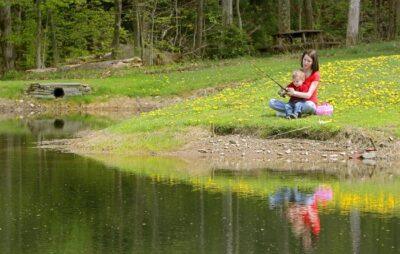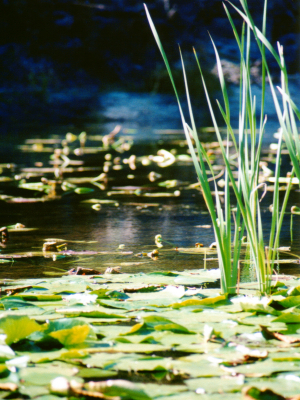
Image source: shutterstock / parenting.com
Teach a man to fish, and you will feed him for a day. Build a man a fishing pond, and he will start competing in bass tournaments and refer to his pond as a lake. He also will have a ready source of food for his family that is fresh, rich in nutrients and high in protein. Should disaster strike, you and your family can have a reproducing source of food.
Of course, you can’t just decide one day to get up a build a pond in your backyard. It can be expensive, take quite a bit of time and all go downhill fast if you haven’t done your homework. There are requirements that must be met before you even consider embarking down this road.
First Steps
First you need land. That’s right – to get water you need land. And you need enough drainage to fill your pond and keep it full. A good rule of thumb is at least 10 acres of land for every one acre of pond you will be building. Next you need to be sure what you are doing is legal in your area. The last thing you will want is a hefty fine and attention from the government.
New Survival Seed Bank™ Lets You Plant A Full Acre Crisis Garden!
While investigating the first two steps, you will have to find out if your land can actually allow for a pond. Does your soil have enough clay in it to prevent water from leaking out of your expensive hole in the ground? If yes, good! If not, you can either truck it in (expensive) or give up (cheap). So if you have the land, the local government doesn’t scowl too much and you have clay, it is time to build the sixth Great Lake, err, I mean your bass pond.
The next step is planning. How big do you want the pond? I would say if you are going to seriously use this as a food (and emergency water) source, it should be at least an acre in size and better yet, two to four acres. Map your pond out and find a water source to keep it filled. This can be a spring on your land or a canal you dig between your pond and a small creek.
 Now it’s time to start the construction process. The pond’s depth depends on you and your land. I would say be sure the channel in the center of the pond is at least 15 to 20 feet deep. If you want any islands or a boat ramp, now will be the time to create them. All aspects of building need to be designed and completed at this stage.
Now it’s time to start the construction process. The pond’s depth depends on you and your land. I would say be sure the channel in the center of the pond is at least 15 to 20 feet deep. If you want any islands or a boat ramp, now will be the time to create them. All aspects of building need to be designed and completed at this stage.
The bulldozer is the best tool for the job on this project. You can build a pond yourself. In fact, you could do it all by hand. But why use a shovel when you can use a diesel? Hiring a contractor is a popular option, but will cost much more in the end.
The cost to build a pond? It could be a couple thousands dollars if you are building it yourself with your own bulldozer or one you borrowed. If you hire a contractor, plan at least $4,000 to $6,000 per acre with good, clay-rich soil. Cost can skyrocket over $10,000 per acre is you have poor-quality clay.
Filling and Stocking
So you have done your homework, mapped the pond out, bulldozed your mini lake into existence and now it is time to prepare your pond for fish. You may want to add natural items to the bottom of your pond before it fills with water. Boulders, downed trees and other forms of cover will help fish find cover for foraging, breeding and protection from other fish.
Discover The World’s Healthiest Storable Survival Food!
How long it will take your pond to fill depends on the pond. For some of you, simply opening the canal to a stream and letting the waters flow can take a few days. Massive rains can do it within hours. Otherwise, plan on it taking a few months.
When your pond has enough water, usually at least four feet in depth, you may be able to begin stocking. You should consider your local climate when selecting the fish you will stock the pond with. For example, in the South, fish species grow quickly and an individual fish will grow in size quickly due to the climate and long growing season. Typically the best thing to do is to stock flathead minnows first, at about 1,000 minnows per acre of water. Stocking in late winter or the early spring is recommended. Then allow a couple months for your flatheads to populate. They are prolific and you will soon notice many minnows swimming close to your pond’s water edge.
The next fish you should consider stocking are bream – specifically bluegill and shellcracker (redear) sunfish. The best stocking rate is at least 500 bluegill and 100 shellcracker per acre in the south. Give your bream the summer to boost their population. In the fall you add your top predator, typically the six-inch largemouth bass at 100 to 150 fish per acre.
Now I know I will get comments such as, “That’s not how to stock in Indiana.” Nope, it sure is not. You are going to need to research very carefully how to establish the proper ecosystem for your part of the country.
Building a pond can be a large task and like any large task, you have to spend long hours researching and planning your project. If you do that, you can have a high-quality, renewable food source for you and your family. Not to mention a great fishing hole.
Have you ever built a pond? What advice would you add? Share it in the section below:
Discover The Trick To Saving Thousands At The Grocery Store. Read More Here.
 Off The Grid News Better Ideas For Off The Grid Living
Off The Grid News Better Ideas For Off The Grid Living



